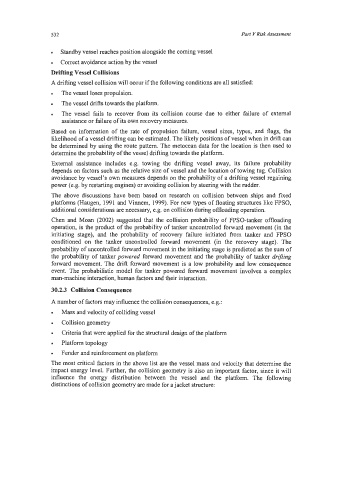Page 556 - Marine Structural Design
P. 556
532 Part V Risk Assessment
Standby vessel reaches position alongside the coming vessel
Correct avoidance action by the vessel
Drifting Vessel Collisions
A drifting vessel collision will occur if the following conditions are all satisfied:
The vessel fails to recover from its collision course due to either failure of external
assistance or failure of its own recovery measures.
Based on information of the rate of propulsion failure, vessel sizes, types, and flags, the
likelihood of a vessel drifting can be estimated. The likely positions of vessel when in drift can
be determined by using the route pattern. The metocean data for the location is then used to
determine the probability of the vessel drifting towards the platform.
External assistance includes e.g. towing the drifting vessel away, its failure probability
depends on factors such as the relative size of vessel and the location of towing tug. Collision
avoidance by vessel's own measures depends on the probability of a drifting vessel regaining
power (e.g. by restarting engines) or avoiding collision by steering with the rudder.
The above discussions have been based on research on collision between ships and fixed
platforms (Haugen, 1991 and Vinnem, 1999). For new types of floating structures like FPSO,
additional considerations are necessary, e.g. on collision during offloading operation.
Chen and Moan (2002) suggested that the collision probability of FPSO-tanker offloading
operation, is the product of the probability of tanker uncontrolled forward movement (in the
initiating stage), and the probability of recovery failure initiated from tanker and FPSO
conditioned on the tanker uncontrolled forward movement (in the recovery stage). The
probability of uncontrolled forward movement in the initiating stage is predicted as the sum of
the probability of tanker powered forward movement and the probability of tanker drifiing
forward movement. The drift forward movement is a low probability and low consequence
event. The probabilistic model for tanker powered forward movement involves a complex
man-machine interaction, human factors and their interaction.
30.2.3 Collision Consequence
A number of factors may influence the collision consequences, e.g.:
Mass and velocity of colliding vessel
Collision geometry
Criteria that were applied for the structural design of the platform
Platform topology
Fender and reinforcement on platform
The most critical factors in the above list are the vessel mass and velocity that determine the
impact energy level. Further, the collision geometry is also an important factor, since it will
influence the energy distribution between the vessel and the platform. The following
distinctions of collision geometry are made for a jacket structure:

